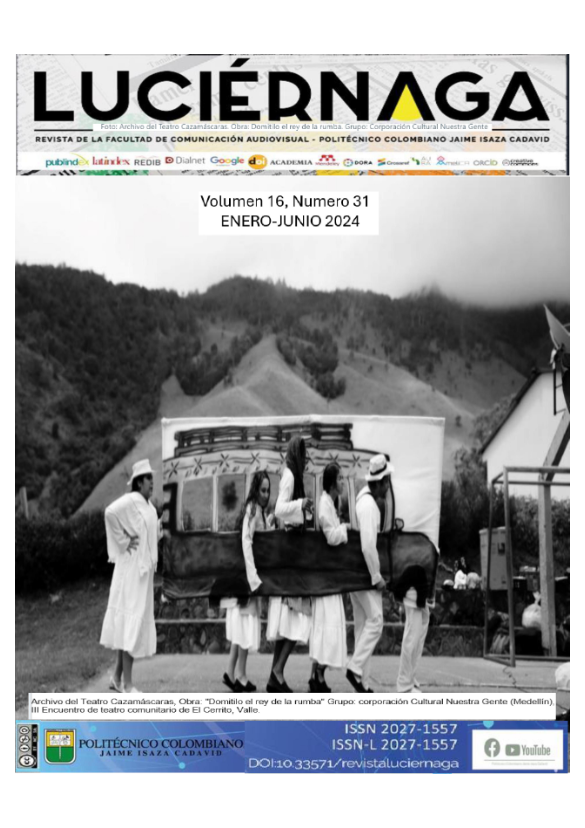Science Fiction In Cinema And New Media In Colombia: A Late Development Of The Vision About The Future
Keywords:
Cinema, New media, Transmedia, Science fiction, Latin AmericaAbstract
Science fiction is a genre that has managed to have a significant boom in the 20th century, however, its development in Latin America from the audiovisual field has been poor because its communities lived (and live) armed conflicts, extreme poverty and dictatorships, promoting its audiovisual artists to develop their films on these themes. In the 21st century, thanks to new technologies, their relationship with art and the implicit perception in their generations from the social, cultural, aesthetic and/or political sphere, proposals are glimpsed that have allowed science fiction to be given a different perspective. in Latin American audiovisuals through new media and transmedia.
This proposal is a tour of science fiction in Colombia in relation to Latin America to determine its importance in the audiovisual field (almost disappeared in the 20th century), and thus, to vindicate itself in the 21st century with significant content in the appearance of proposals for new media and transmedia in science fiction, because now the past and memory are not the only thing that matters, but also the future and everything that thinking about the future means, collecting projects of this style that are beginning to emerge and that have modified the perception of audiovisual and its classical structure.
Article Metrics
Abstract: 449 PDF (Español (España)): 197References
Arcila, P. (2018, mayo 29). Conozca «Gravedad 1», la historia de una industria naciente. http://proyecta.senalcolombia.tv/testimonios/gravedad-1-una-historia-animada-en-el-marco-de-la-ciencia-ficcion
Basile, A., Guerra, R., Mora, P., & Sánchez, J. (directores). (2001). Bogotá 2016 [Ciencia ficción; 35 mm]. Centauro Fimls.
Barcelo, M. (2015). Ciencia Ficción. Nueva guía de lectura. Penguin Random House Grupo Editorial España.
Bastidas, F. F. (2021). El tercer mundo después del sol (I). Minotauro. https://www.academia.edu/49056816/El_tercer_mundo_despu%C3%A9s_del_sol
Bastidas, R. (2022). Cuerpos lunares y de otras dimensiones. Folomena Edita.
Berdet, M. (2016). Gótico tropical y surrealismo. La novela negra de Caliwood. Acta Poética, 37(2), 35. https://doi.org/10.19130/iifl.ap.2016.2.733
Cabezas Garrido, J. A. (2010). VIAJE, CIENCIA FICCIÓN, ARQUITECTURA. MAPAS, ESTACIONES Y ESPEJOS. Proyecto, Progreso, Arquitectura, 3, 136-155. https://doi.org/10.12795/ppa.2010.i3.09
¿Cómo se hace un Universo Transmedia como el de «La Peste»? (2019, noviembre 30). El Español. https://www.elespanol.com/bluper/television/20191130/hace-universo-transmedia-peste/448455811_0.html
Díaz-Barrera, N., & Cabezas-Cabrera, A. (2019). Hibridación cultural: Aperturas y clausuras epistémicas desde la teoría del pensamiento complejo. Revista de Educación Básica, 11. http://200.9.234.120/handle/ucm/repositorio.ucm.cl/handle/ucm/2995
En Búsqueda Bogotá. (2015). En Búsqueda Bogotá. https://enbusquedabogota.wordpress.com/
Esteve, F. (2016, marzo 22). Afrofuturismo, ciencia ficción e identidad africana. CCCB LAB. https://lab.cccb.org/es/afrofuturismo-ciencia-ficcion-e-identidad-africana/
Franco, M., & Castaño, J. (2008, octubre). Género de cine fantástico. ¿Existe cine fantástico en Colombia? Luciérnaga Audiovisual, 1. https://www.politecnicojic.edu.co/images/downloads/publicaciones/revista-luciernaga/luciernaga-01/genero_de_cine_fantastico.html
Kokotovic, M. (2000). Hibridez y desigualdad:
García Canclini ante el neoliberalismo. Revista de Crítica Literaria Latinoamericana, 26(52), 289-300. https://doi.org/10.2307/4531134
Kurlat, S. (2012). La ciencia ficción en América Latina: Entre la mitología experimental y lo que vendrá. Revista Iberoamericana, LXXVIII, 15-22.
La Chimenea Cultural. (2021). Aleteo-transmedia. Aleteo-Transmedia. https://aleteotransmedia.com/
Moro, T. (2016). Utopía. Edu Rosby. https://www.textos.info/tomas-moro/utopia/pdf
Ocampo, A. R., de Norden, I., & de Vargas, C. T. (1982). Cuadernos de cine colombiano 8. Cinemateca Distrital, 8, 28.
Santiago Pidre, R. (2018). LA CIUDAD DEL FUTURO Y SU RELACIÓN CON LA CIENCIA FICCIÓN EN CINE Y TELEVISIÓN. Proceedings of the 6th Creatives Cities, Orlando 2018, 921-937. https://doi.org/10.7195/piccc.00048
Tamayo, C., Freeman, M., & Morales, E. (2018). Arqueología transmedia en América Latina: Mestizajes, identidades y convergencias (1. ed). Editorial EAFIT.
Tubau, D. (2011). El guión del siglo 21 (Primera). Alba Editorial.
Downloads
Published
How to Cite
Issue
Section
License
Copyright (c) 2024 Edison Albear Gonzalez Lemus

This work is licensed under a Creative Commons Attribution-NonCommercial-ShareAlike 4.0 International License.
Aquellos autores/as que tengan publicaciones con esta revista, aceptan los términos siguientes:- Los autores/as conservarán sus derechos de autor y garantizarán a la revista el derecho de primera publicación de su obra, el cuál estará simultáneamente sujeto a una licencia de Creative Commons Atribución – No comercial – Compartir igual
que permite a terceros compartir la obra siempre que se indique su autor y su primera publicación en esta revista. - Los autores/as podrán adoptar otros acuerdos de licencia no exclusiva de distribución de la versión de la obra publicada (p. ej.: depositarla en un archivo telemático institucional o publicarla en un volumen monográfico) siempre que se indique la publicación inicial en esta revista.
- Se permite y recomienda a los autores/as difundir su obra a través de Internet (p. ej.: en archivos telemáticos institucionales o en su página web) antes y durante el proceso de envío, lo cual puede producir intercambios interesantes y aumentar las citas de la obra publicada. (Véase El efecto del acceso abierto)
- Luciérnaga-Comunicación no cobra tasas o cargos a Autores o colaradores por la recepción, revisión o publicación de artículos (APC -Article Processing Charges/ publication fee).













